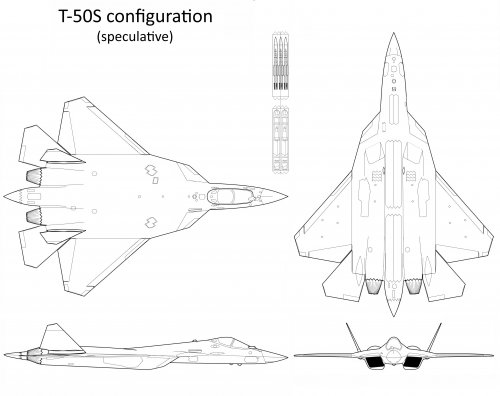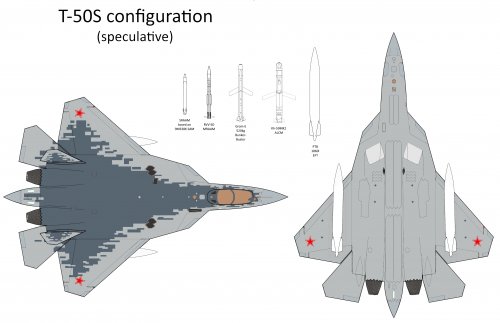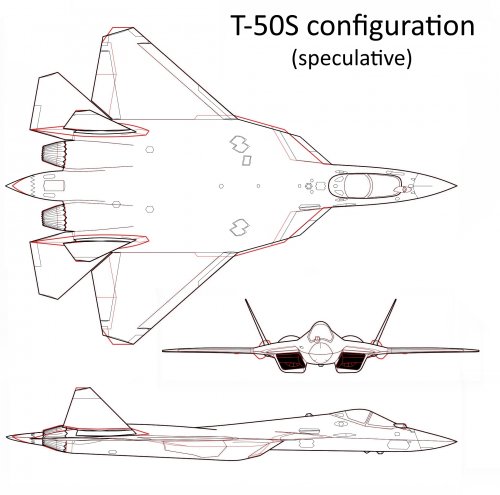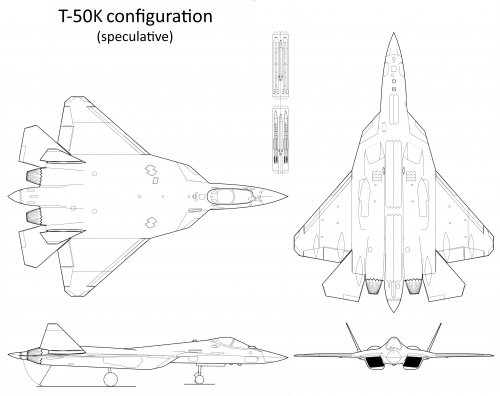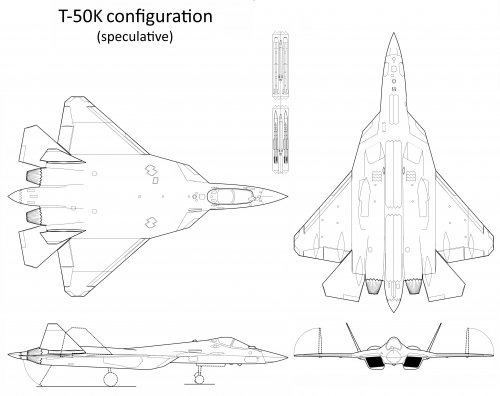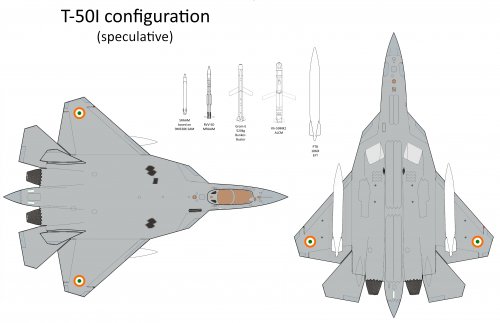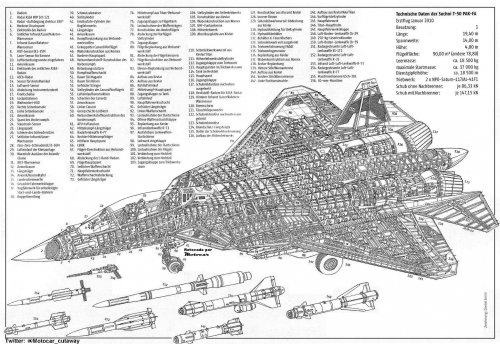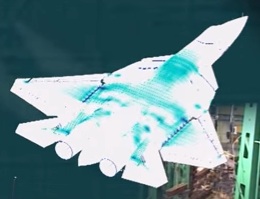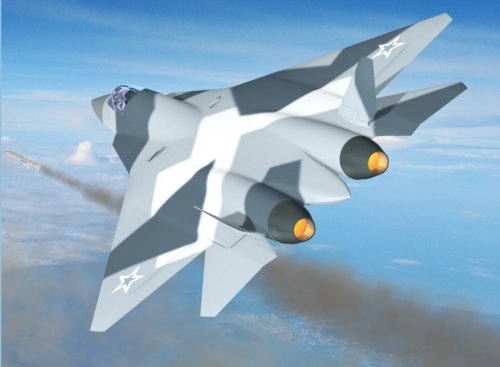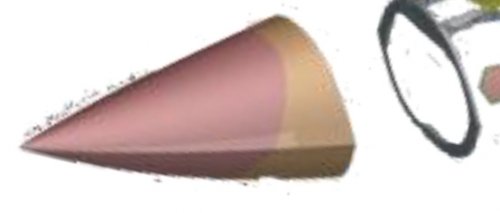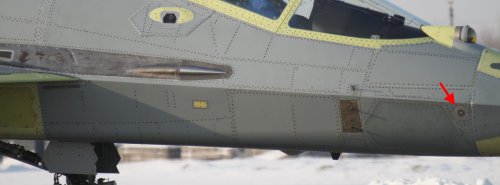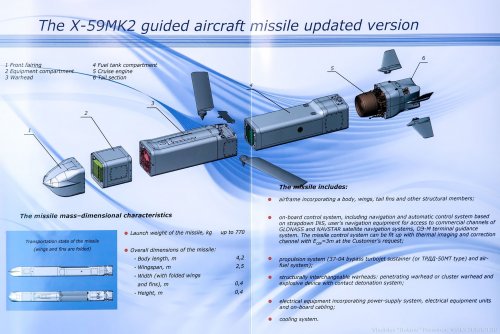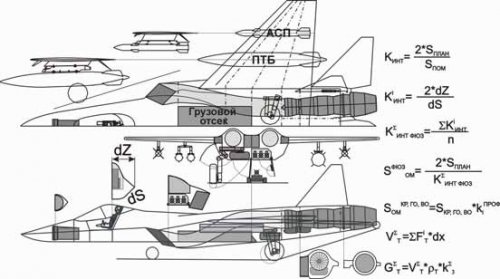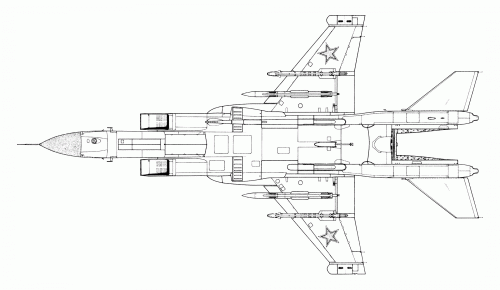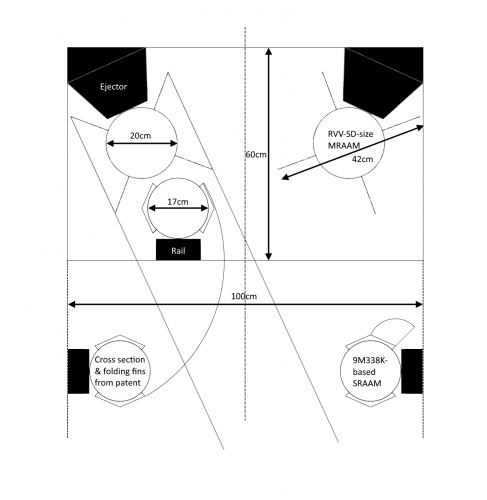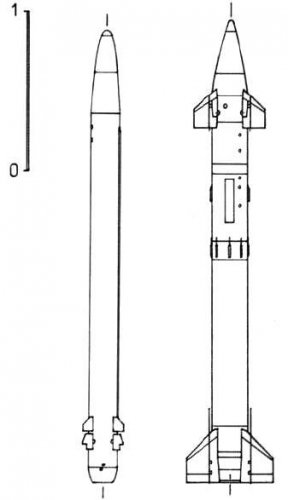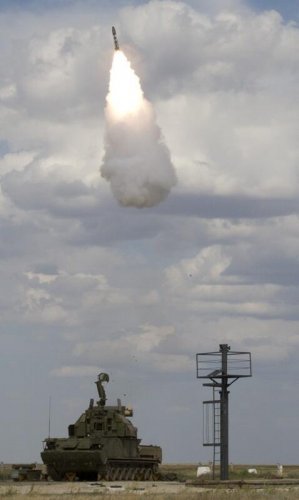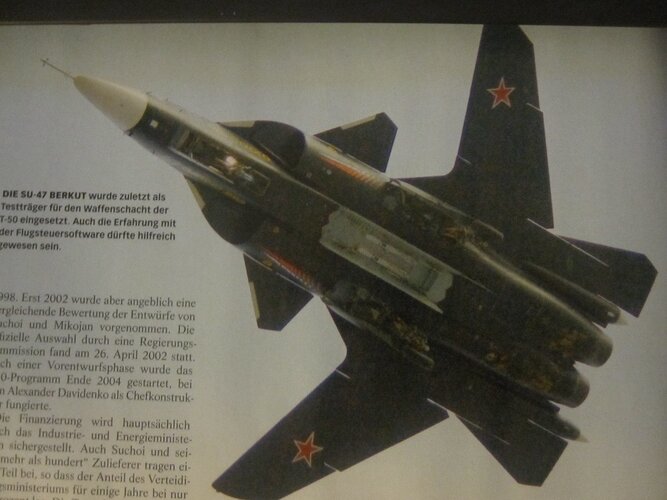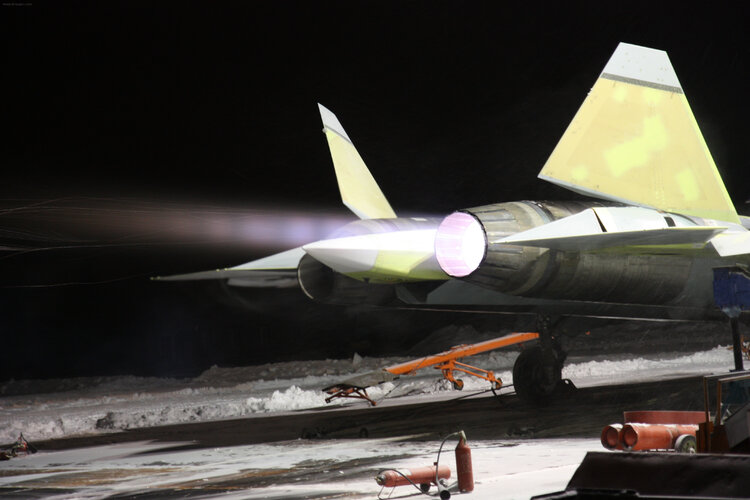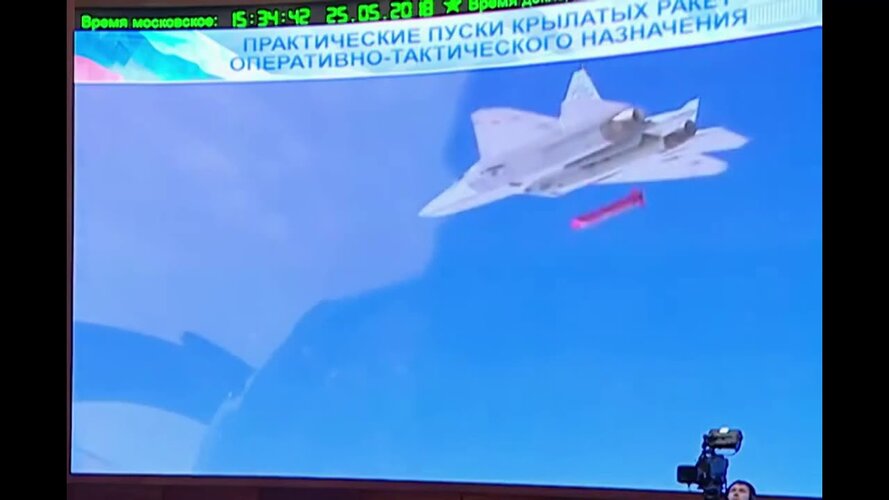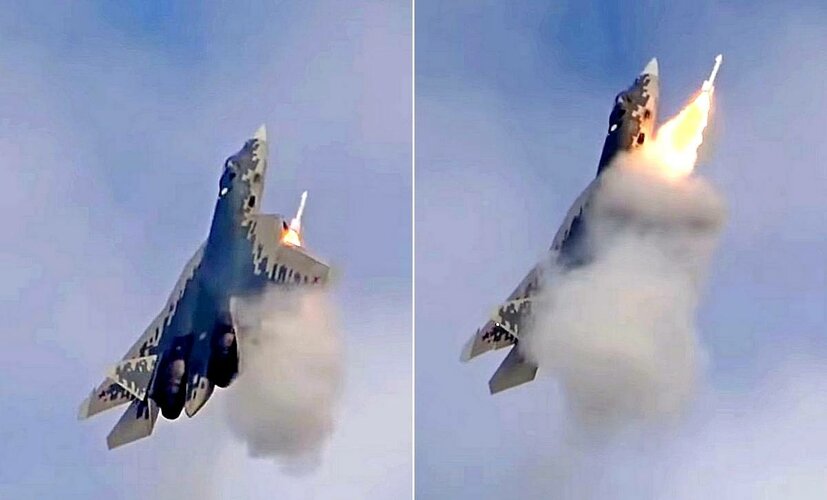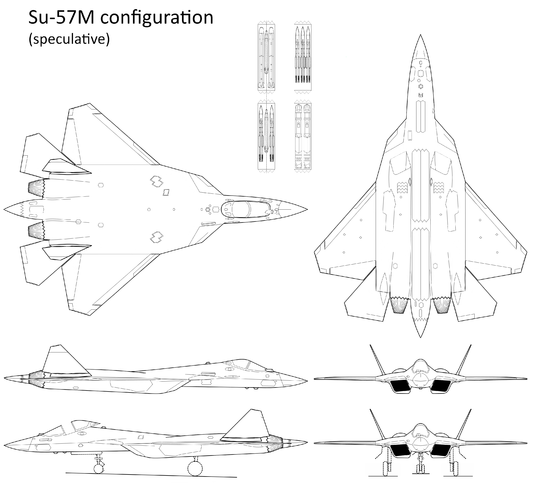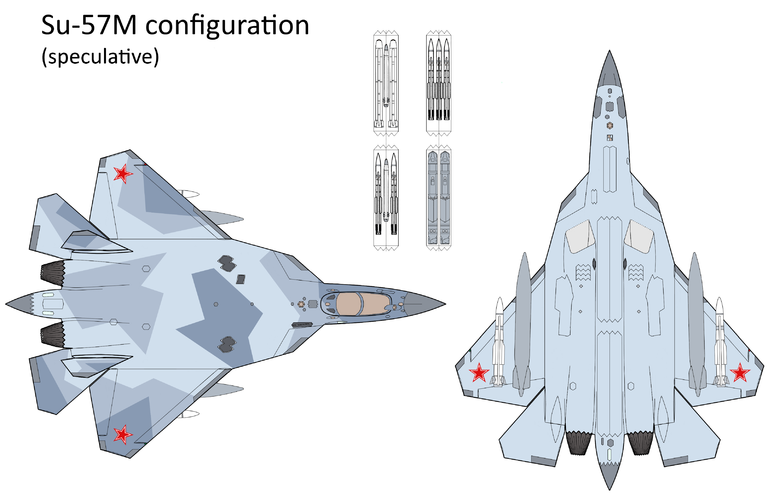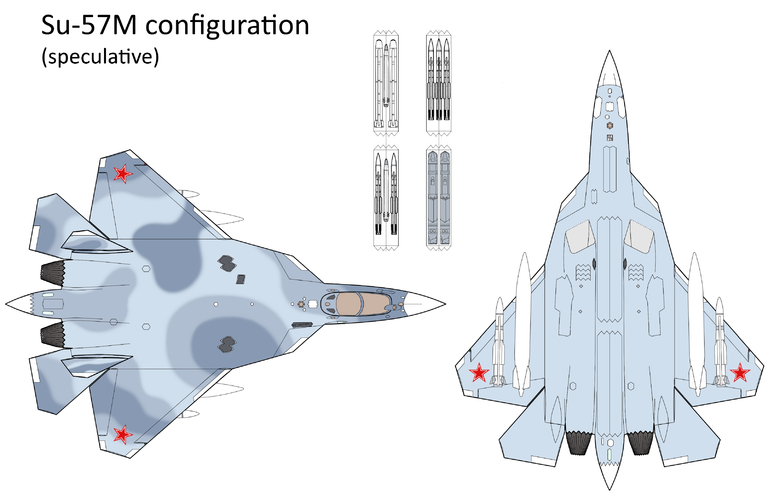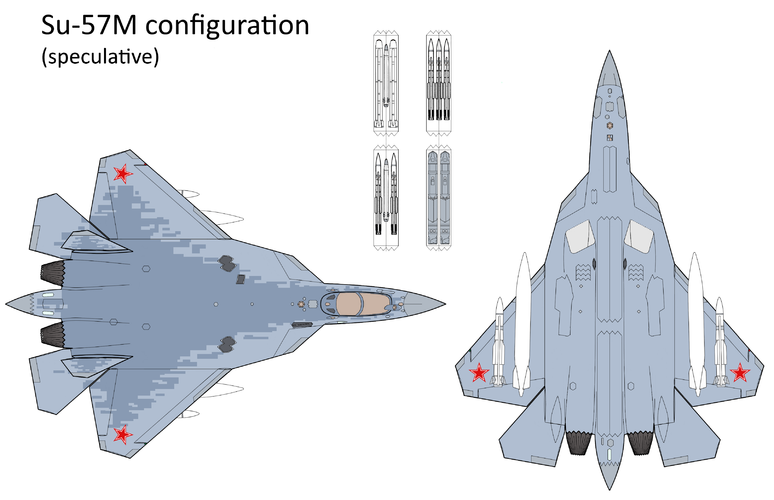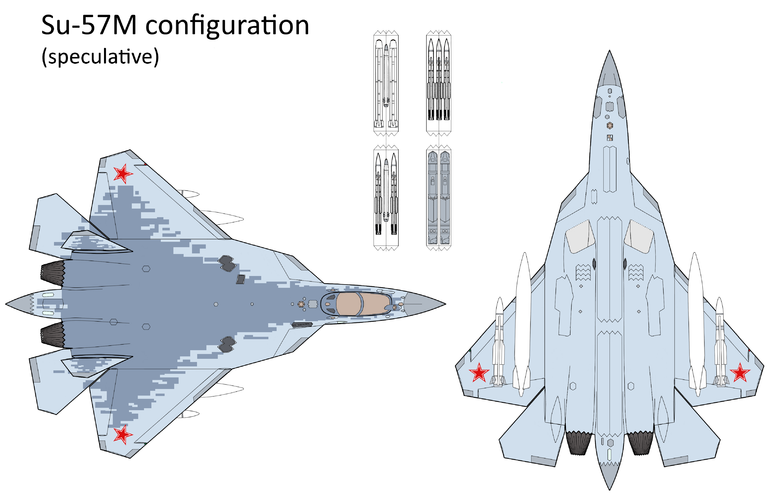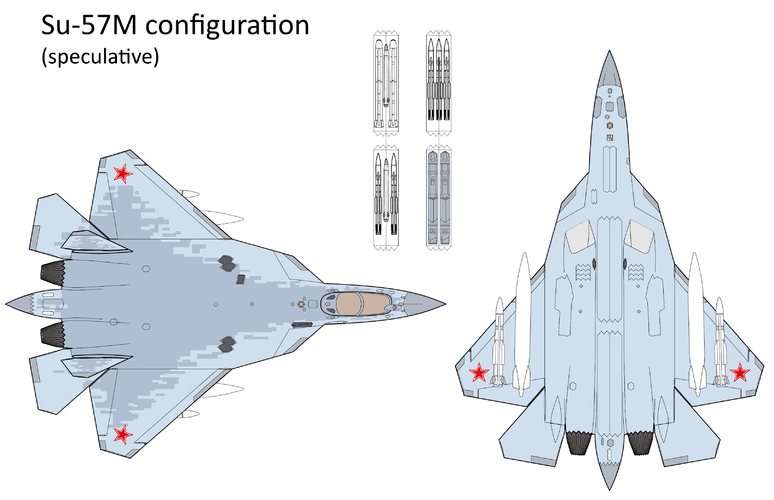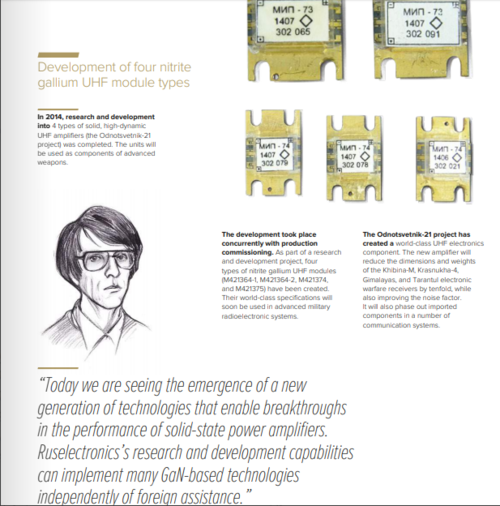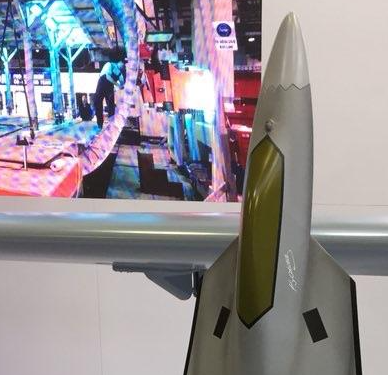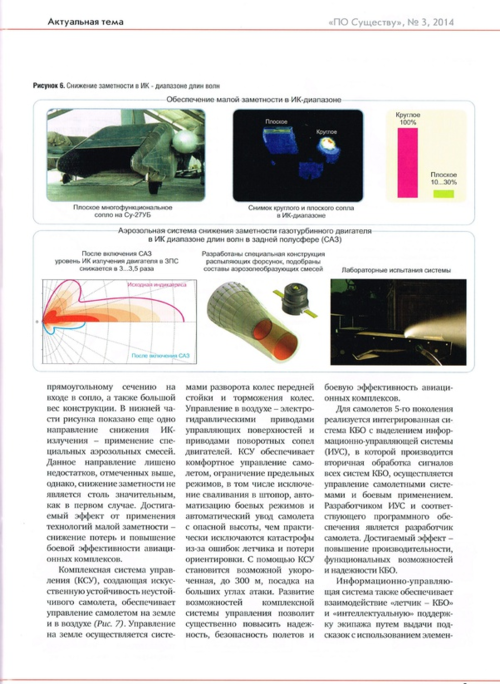So I've always believed Sukhoi was fundamentally onto something with the T-50 configuration, but wasn't quite tapping its full potential. The implementation seemed a bit cumbersome, which is most un-Sukhoi-like really, when you consider the elegant simplicity of the Su-27 or Su-35S. Some of the criticism aimed at its stealth characteristics is apparently also based on this argument of excessive complexity.
These drawings represent my attempt to address these concerns while preserving the current structure and principal layout as much as practical. They are based on the high-res 3-view drawing from a patent describing the T-50 configuration (a comparison with the original in red is shown in the 3rd image). Changes include:
- SRAAM bays deleted One of the advantages of the Su-57 is the impressive size of its main weapons bays, yet oddly there appears to be no ambition to carry more than 6 AAMs (4 MRAAMs + 2 SRAAMs). Such a load could be easily accommodated in the centreline bays (the size of which is obviously driven by certain A/G munitions) alone, so the presence of separate SRAAM bays probably derives purely from an intention to provide good seeker FOV for LOBL missiles. With reliable LOAL becoming much more realistic thanks to near-field situational awareness sensors (EODAS) and modern SRAAMs equipped with datalink, this approach seems like poor choice to me. It burdens the aircraft with a very onerous feature that is rendered obsolete quite early into its service life, especially so if in this case the bays are actually sized to accommodate the very bulky R-73. With the F-35 making no allowance for internal SRAAM carriage at all, temporarily abandoning SRAAM capability pending the introduction of a successor missile seems more efficient. The benefits: more room for fuel, lower drag, reduced weight, fewer moving parts to maintain, lower RCS. More on the missile which might enable this change further down.
- LERX aspect ratio reduced The absence of the SRAAM bays offers an opportunity to slim down the span of the LERX, to maintain area & LE sweep angle (edge alignment) they instead extend slightly further forward. I took care to maintain approximately the same LERX and LEVCON areas with these changes. To be perfectly frank, this change was at least partly motivated by aesthetics
- Single trailing edge flaperon The actuators move into the sides of the intake/engine nacelles instead of underwing actuator bulges. Benefits: fewer moving parts to maintain and gaps to RAM-treat, cleaner outer mold line.
- Fixed isentropic intake ramps Possibly one of the strangest aspects of the Su-57 is the presence of variable intake ramps. On an airframe obviously designed for low supersonic drag (high wing sweep angle etc.) and with a top speed goal of reportedly no more than Mach 2.0, a variable intake seems like an unnecessary RCS burden. My guess is that this is a consequence of a plan to rush the aircraft into service with the AL-31F-derived interim Izd. 117 engines, which might need this feature to achieve a useful supercruise capability. With the Su-57 now unlikely to enter service in any meaningful numbers before the definitive Izd. 30 engine becomes available, this feature can be dispensed with. Benefits: lower weight, fewer moving parts to maintain and RAM-treat.
- Modified intake boundary layer diverter/bleed system The upper BL diverter gap is eliminated in favour of a YF-23-like advanced bleed system to remove a cavity for RCS reduction. While the gap between the fuselage and intake remains, I've moved the ECS intakes into it - although the original location in the leading edge of the tailfin pedestal was pretty cleverly chosen (out of view of threats below the aircraft), the BL cavity exists & has to be treated anyway. You might as well kill two birds with one stone and take advantage of the inevitable effort to get stealthy ECS inlets 'free' (this is also the approach adopted by the F-22). Cooling air for the engine bay and engine oil heat exchanger are tapped off the main inlet duct (its area is slighter bigger due to the removal of the upper BL diverter gap anyway) instead, again as per the YF-23. The outlets for upper intake ramp bleed air are moved to the upper surface of the LERX (placing them out of view of most threats) and adopt a shape based on an 'intersected-pair' version of the current caret-shaped aperture on the outside of the nacelles. Those on the inside (facing the inlet tunnel) are retained but changed to the low-RCS caret-shape of the ones on the outside. Benefits: lower RCS, shorter ducting for the ECS heat exchangers.
- Serrated auxiliary intake louvres Later prototypes have a mesh screen over the intakes, but I think serrated louvres (essentially a reverse of the F-22 excess air bleed doors on the spine) would work better as they extend down to effectively form air scoops. Unlike the Raptor's spill doors (which are actively actuated and move during the pre-flight BITE sequence) they'd be spring-loaded as on the Su-27, making for an entirely 'passive' intake system. In up-and-away high-speed flight they'd be closed (again unlike the F-22), so the fact that they're located on the belly is probably ok. Benefit: better high-AoA intake performance at low RCS.
- FOD screens deleted This is a tough one... the current visor-like screens are a potential RCS issue with the straight ducts (blocker for engine masking). A study of nose gear FOD hazard for the C-130 which I read indicates the impact risk area starts about 2.4m aft of the nosewheels... on the Su-57, the forward-most point on the lower inlet lip is 2.5m aft, but about 0.2m higher off the ground than the lower fuselage of the C-130. Looking at the (Y)F-23 and the Hornet family, the inlets are further aft (considerably so on the F-23, moderately on the F/A-18), height above ground is pretty similar in all of them and the Su-57 inlets are wider apart than the Hornet's but closer together than the F-23's. On the latter, you can argue based on the C-130 study that they are far enough apart to be outside the FOD risk area, but the Hornet is at least as affected as the Su-57 is. As a result, with the Su-57 additionally having a nose landing gear mud guard that the others lack, it seems the adoption of FOD screens was driven by more stringent austere field requirements rather than a genuinely more FOD prone design. On these grounds, I'd get rid of the screens in exchange for greater restrictions on airfield apron/runway "hygiene". Benefit: lower mechanical complexity, reduced weight, lower RCS.
- Slimmed down tail fin pedestal to a pylon With the ECS/cooling air scoop gone, moving the taileron actuators into fairings below the 'waterline' (think F-35) allows the fat pedestal to be slimmed down to a narrow pylon. Benefit? It looks better Especially as I actually like those spindle-shaped 'Kuchemann Carrots', so having deleted four of them from under the wings, introducing a new pair under the tail is a good compromise. More seriously, it does "free up" some cross sectional area for better shaping/blending of the engine/intake nacelles (see below).
Especially as I actually like those spindle-shaped 'Kuchemann Carrots', so having deleted four of them from under the wings, introducing a new pair under the tail is a good compromise. More seriously, it does "free up" some cross sectional area for better shaping/blending of the engine/intake nacelles (see below).
- Re-shaped, more blended engine/intake nacelle fairing This isn't really visible in these drawings, but I would change the cross section of the nacelles to be more trapezoidal and blend more smoothly into the fuselage/wing, giving an OML rather like the J-20 engine fairings. The "spare" cross sectional area from an area ruling point of view for the change comes from getting rid of the SRAAM bays and fin pedestal described above, it also eliminates the break in the OML form the main landing gear door bulges (they just fair in smoothly). Benefit: Cleaner OML, lower RCS.
- Canted radar antenna bulkhead Flateric posted a CAD image of such a design sometime ago, so I included it. Benefit: lower RCS.
- Facetted IRST & DIRCM apertures Self-explanatory really. The IRST and both DIRCM windows are currently spherical domes which isn't optimal for radar signature (the IRST apparently has an elaborately treated backface which is exposed when it's not in use, but that forces the pilot to choose between stealthy passive sensor and stealthy airframe shape). Benefit: lower RCS, especially with IRST in use.
- Two rather than five nose landing gear doors, nosewheels without trailing link The doors open through substantially more than 90° to minimize destabilizing area in yaw (this problem apparenly caused the F-35 to switch from one door to split halves and may have driven the current Su-57 solution). An overall less bulky nose landing gear design (see fourth picture of the navalized variant) aids this approach. Benefit: fewer moving parts, lower RCS.
- Aligned taileron hinge line Currently the hinge is perpendicular to the aircraft centreline, I aligned it with the wing & taileron trailing edge angle. Benefit: lower RCS.
- Frangible covers for the gun muzzle & chaff/flare dispensers Currently they are hidden by actively controlled doors (though not serrated in the dispensers...). Needless complication IMHO, once a stealthy aircraft has to deploy expendable countermeasures or fire the gun, its cloak can be considered blown I'd say. Benefit: lower maintenance impact.
- Upper hemisphere MAWS/EODAS apertures repositioned They are currently placed into a small pyramidical enclosure like those for the lower hemisphere, though located quite a bit behind of the cockpit. I placed them into more Su-35S-like locations fore and aft of the canopy (the rear sensor actually on the moving part of the canopy). Benefit: the location of all sensors very close to the head of the pilot probably makes an EODAS-style near-field situational awareness function easier to implement.
- Serrated sundry RF apertures & access panels A surprising number of them are serrated anyway, but I tended to those that weren't already. Benefit: lower RCS.
- Wing & fin tips cropped at same angle as tailerons Benefit: purely aesthetical, really. On the wing tips it may give better edge alignment than before, but mostly it's just artistic license
In summary, the major items are the deletion of the SRAAM bays, re-shaped LERX, switch to a single-piece flaperon and numerous measures to simplify the intakes (fixed ramps, revised BL bleed system, auxiliary louvres and removal of the FOD screens). The rest is small change really, and even all together the scale of the modifications is smaller than what went on between the original T-10 and the production Su-27 (although there are a couple of remarkable parallels...).
The final drawing shows a navalized version which adopts the short tail sting from the patent drawing (representing the early prototypes). Ironically, it's closer to the current Su-57 in some respects, such as the wing and fin tip crops, the split flaperons (to accommodate the wing fold & enable inboard fixed vane slotted flaps) and the associated actuator fairings. I also re-introduced bulged main landing gear doors, to accommodate a possibly beefier gear. So if, looking at the comparison image, you were wondering what the original belly view (which was not in the patent drawing) would look like, the navalized variant provides a rough indication. The outboard flaperon actuator fairing is slightly closer to the wing tip though, to ensure it is outboard of the folding hinge. There is a tail hook compartment which partially intrudes on the rear weapons bay such that the middle slot can only hold a SRAAM (as shown in the drawing) and I assumed mission-adaptive flexible seal LE flaps as on the Su-27KUB. Finally, the brake parachute is gone, in its location is the chaff/flare dispenser displaced by the tail hook.
Whew... that's it - I think. If you've spotted something that I didn't mention, ask away: there's a pretty good chance that it's deliberate and was done with a specific purpose in mind. I'll add sources and sources of inspiration in another post later.
These drawings represent my attempt to address these concerns while preserving the current structure and principal layout as much as practical. They are based on the high-res 3-view drawing from a patent describing the T-50 configuration (a comparison with the original in red is shown in the 3rd image). Changes include:
- SRAAM bays deleted One of the advantages of the Su-57 is the impressive size of its main weapons bays, yet oddly there appears to be no ambition to carry more than 6 AAMs (4 MRAAMs + 2 SRAAMs). Such a load could be easily accommodated in the centreline bays (the size of which is obviously driven by certain A/G munitions) alone, so the presence of separate SRAAM bays probably derives purely from an intention to provide good seeker FOV for LOBL missiles. With reliable LOAL becoming much more realistic thanks to near-field situational awareness sensors (EODAS) and modern SRAAMs equipped with datalink, this approach seems like poor choice to me. It burdens the aircraft with a very onerous feature that is rendered obsolete quite early into its service life, especially so if in this case the bays are actually sized to accommodate the very bulky R-73. With the F-35 making no allowance for internal SRAAM carriage at all, temporarily abandoning SRAAM capability pending the introduction of a successor missile seems more efficient. The benefits: more room for fuel, lower drag, reduced weight, fewer moving parts to maintain, lower RCS. More on the missile which might enable this change further down.
- LERX aspect ratio reduced The absence of the SRAAM bays offers an opportunity to slim down the span of the LERX, to maintain area & LE sweep angle (edge alignment) they instead extend slightly further forward. I took care to maintain approximately the same LERX and LEVCON areas with these changes. To be perfectly frank, this change was at least partly motivated by aesthetics
- Single trailing edge flaperon The actuators move into the sides of the intake/engine nacelles instead of underwing actuator bulges. Benefits: fewer moving parts to maintain and gaps to RAM-treat, cleaner outer mold line.
- Fixed isentropic intake ramps Possibly one of the strangest aspects of the Su-57 is the presence of variable intake ramps. On an airframe obviously designed for low supersonic drag (high wing sweep angle etc.) and with a top speed goal of reportedly no more than Mach 2.0, a variable intake seems like an unnecessary RCS burden. My guess is that this is a consequence of a plan to rush the aircraft into service with the AL-31F-derived interim Izd. 117 engines, which might need this feature to achieve a useful supercruise capability. With the Su-57 now unlikely to enter service in any meaningful numbers before the definitive Izd. 30 engine becomes available, this feature can be dispensed with. Benefits: lower weight, fewer moving parts to maintain and RAM-treat.
- Modified intake boundary layer diverter/bleed system The upper BL diverter gap is eliminated in favour of a YF-23-like advanced bleed system to remove a cavity for RCS reduction. While the gap between the fuselage and intake remains, I've moved the ECS intakes into it - although the original location in the leading edge of the tailfin pedestal was pretty cleverly chosen (out of view of threats below the aircraft), the BL cavity exists & has to be treated anyway. You might as well kill two birds with one stone and take advantage of the inevitable effort to get stealthy ECS inlets 'free' (this is also the approach adopted by the F-22). Cooling air for the engine bay and engine oil heat exchanger are tapped off the main inlet duct (its area is slighter bigger due to the removal of the upper BL diverter gap anyway) instead, again as per the YF-23. The outlets for upper intake ramp bleed air are moved to the upper surface of the LERX (placing them out of view of most threats) and adopt a shape based on an 'intersected-pair' version of the current caret-shaped aperture on the outside of the nacelles. Those on the inside (facing the inlet tunnel) are retained but changed to the low-RCS caret-shape of the ones on the outside. Benefits: lower RCS, shorter ducting for the ECS heat exchangers.
- Serrated auxiliary intake louvres Later prototypes have a mesh screen over the intakes, but I think serrated louvres (essentially a reverse of the F-22 excess air bleed doors on the spine) would work better as they extend down to effectively form air scoops. Unlike the Raptor's spill doors (which are actively actuated and move during the pre-flight BITE sequence) they'd be spring-loaded as on the Su-27, making for an entirely 'passive' intake system. In up-and-away high-speed flight they'd be closed (again unlike the F-22), so the fact that they're located on the belly is probably ok. Benefit: better high-AoA intake performance at low RCS.
- FOD screens deleted This is a tough one... the current visor-like screens are a potential RCS issue with the straight ducts (blocker for engine masking). A study of nose gear FOD hazard for the C-130 which I read indicates the impact risk area starts about 2.4m aft of the nosewheels... on the Su-57, the forward-most point on the lower inlet lip is 2.5m aft, but about 0.2m higher off the ground than the lower fuselage of the C-130. Looking at the (Y)F-23 and the Hornet family, the inlets are further aft (considerably so on the F-23, moderately on the F/A-18), height above ground is pretty similar in all of them and the Su-57 inlets are wider apart than the Hornet's but closer together than the F-23's. On the latter, you can argue based on the C-130 study that they are far enough apart to be outside the FOD risk area, but the Hornet is at least as affected as the Su-57 is. As a result, with the Su-57 additionally having a nose landing gear mud guard that the others lack, it seems the adoption of FOD screens was driven by more stringent austere field requirements rather than a genuinely more FOD prone design. On these grounds, I'd get rid of the screens in exchange for greater restrictions on airfield apron/runway "hygiene". Benefit: lower mechanical complexity, reduced weight, lower RCS.
- Slimmed down tail fin pedestal to a pylon With the ECS/cooling air scoop gone, moving the taileron actuators into fairings below the 'waterline' (think F-35) allows the fat pedestal to be slimmed down to a narrow pylon. Benefit? It looks better
- Re-shaped, more blended engine/intake nacelle fairing This isn't really visible in these drawings, but I would change the cross section of the nacelles to be more trapezoidal and blend more smoothly into the fuselage/wing, giving an OML rather like the J-20 engine fairings. The "spare" cross sectional area from an area ruling point of view for the change comes from getting rid of the SRAAM bays and fin pedestal described above, it also eliminates the break in the OML form the main landing gear door bulges (they just fair in smoothly). Benefit: Cleaner OML, lower RCS.
- Canted radar antenna bulkhead Flateric posted a CAD image of such a design sometime ago, so I included it. Benefit: lower RCS.
- Facetted IRST & DIRCM apertures Self-explanatory really. The IRST and both DIRCM windows are currently spherical domes which isn't optimal for radar signature (the IRST apparently has an elaborately treated backface which is exposed when it's not in use, but that forces the pilot to choose between stealthy passive sensor and stealthy airframe shape). Benefit: lower RCS, especially with IRST in use.
- Two rather than five nose landing gear doors, nosewheels without trailing link The doors open through substantially more than 90° to minimize destabilizing area in yaw (this problem apparenly caused the F-35 to switch from one door to split halves and may have driven the current Su-57 solution). An overall less bulky nose landing gear design (see fourth picture of the navalized variant) aids this approach. Benefit: fewer moving parts, lower RCS.
- Aligned taileron hinge line Currently the hinge is perpendicular to the aircraft centreline, I aligned it with the wing & taileron trailing edge angle. Benefit: lower RCS.
- Frangible covers for the gun muzzle & chaff/flare dispensers Currently they are hidden by actively controlled doors (though not serrated in the dispensers...). Needless complication IMHO, once a stealthy aircraft has to deploy expendable countermeasures or fire the gun, its cloak can be considered blown I'd say. Benefit: lower maintenance impact.
- Upper hemisphere MAWS/EODAS apertures repositioned They are currently placed into a small pyramidical enclosure like those for the lower hemisphere, though located quite a bit behind of the cockpit. I placed them into more Su-35S-like locations fore and aft of the canopy (the rear sensor actually on the moving part of the canopy). Benefit: the location of all sensors very close to the head of the pilot probably makes an EODAS-style near-field situational awareness function easier to implement.
- Serrated sundry RF apertures & access panels A surprising number of them are serrated anyway, but I tended to those that weren't already. Benefit: lower RCS.
- Wing & fin tips cropped at same angle as tailerons Benefit: purely aesthetical, really. On the wing tips it may give better edge alignment than before, but mostly it's just artistic license
In summary, the major items are the deletion of the SRAAM bays, re-shaped LERX, switch to a single-piece flaperon and numerous measures to simplify the intakes (fixed ramps, revised BL bleed system, auxiliary louvres and removal of the FOD screens). The rest is small change really, and even all together the scale of the modifications is smaller than what went on between the original T-10 and the production Su-27 (although there are a couple of remarkable parallels...).
The final drawing shows a navalized version which adopts the short tail sting from the patent drawing (representing the early prototypes). Ironically, it's closer to the current Su-57 in some respects, such as the wing and fin tip crops, the split flaperons (to accommodate the wing fold & enable inboard fixed vane slotted flaps) and the associated actuator fairings. I also re-introduced bulged main landing gear doors, to accommodate a possibly beefier gear. So if, looking at the comparison image, you were wondering what the original belly view (which was not in the patent drawing) would look like, the navalized variant provides a rough indication. The outboard flaperon actuator fairing is slightly closer to the wing tip though, to ensure it is outboard of the folding hinge. There is a tail hook compartment which partially intrudes on the rear weapons bay such that the middle slot can only hold a SRAAM (as shown in the drawing) and I assumed mission-adaptive flexible seal LE flaps as on the Su-27KUB. Finally, the brake parachute is gone, in its location is the chaff/flare dispenser displaced by the tail hook.
Whew... that's it - I think. If you've spotted something that I didn't mention, ask away: there's a pretty good chance that it's deliberate and was done with a specific purpose in mind. I'll add sources and sources of inspiration in another post later.

